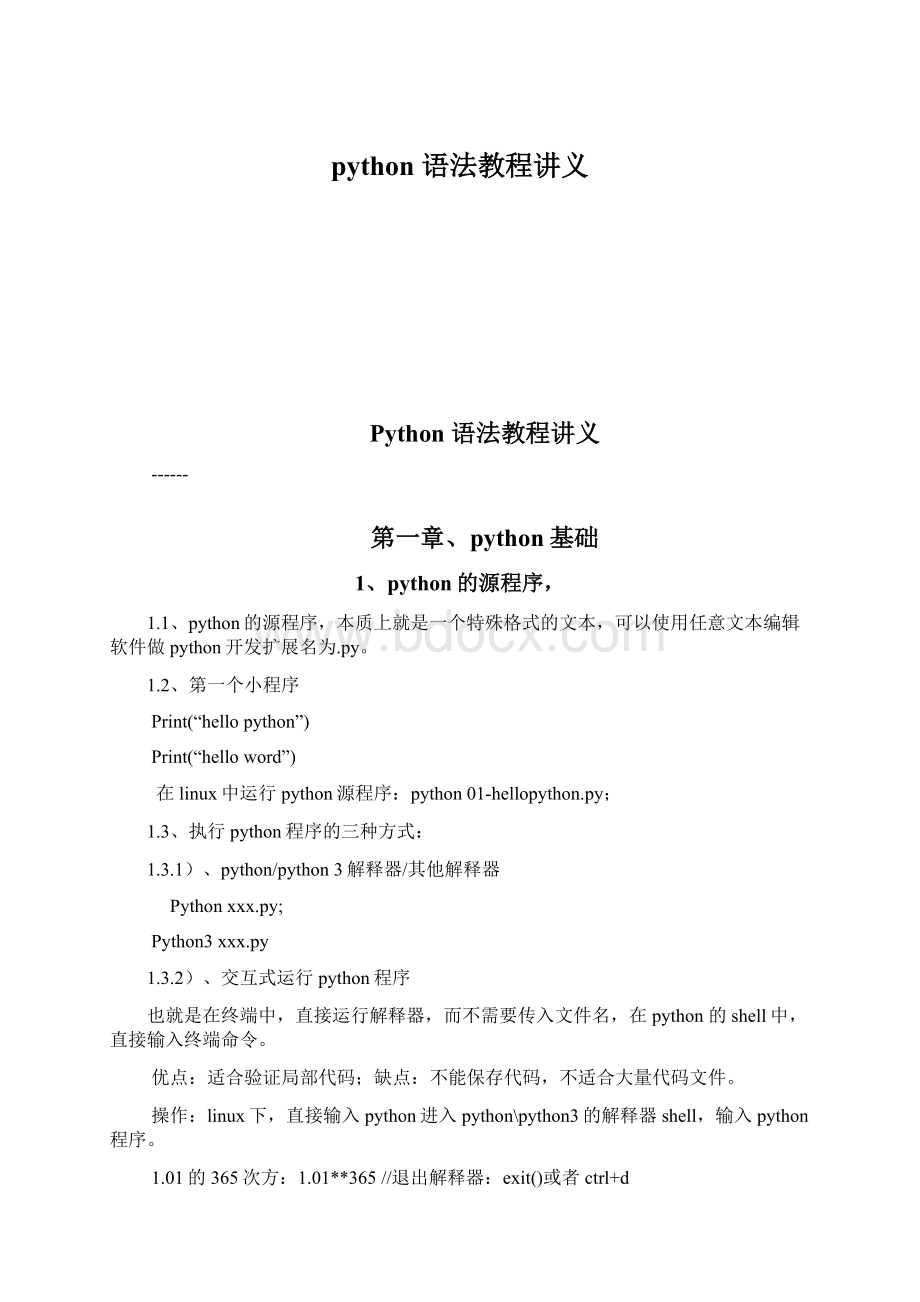python 语法教程讲义文档格式.docx
《python 语法教程讲义文档格式.docx》由会员分享,可在线阅读,更多相关《python 语法教程讲义文档格式.docx(18页珍藏版)》请在冰豆网上搜索。

While:
Foriinrange(3):
命名规范:
1、只能包括字母、数字、下划线;
2、只能以字母或者下划线开头;
3、不能包括空格;
4、不能与关键字冲突;
字符串:
用单引号、双引号括起来的,都是字符串;
Print(“fvr”+str(age)+”fvrv”),使用str()来转换为字符串;
1)、变量名.title(),将变量名的首字母转换成大写字母;
使用+来拼接字符串;
\n\t换行退格;
2)、删除空格,.rstrip();
3)、print可以使用多个,分离,连续输出,但是使用,会添加空格。
Print(‘scdc’,mr)
4)、print("
第{0}天体重为:
{1}"
.format(day,height))
5)、注释单行/多行代码:
选中+ctrl+/
3.1、数据类型转换
字符串转int:
num='
21'
int1=int(num)
print(int1)
4、列表
列表是一系列按特定顺序排列的元素组成,可以创建包含任何没有关联的元素。
4.1、创建列表
Bicycle=[‘trek’,’rgtg’,‘cec’]
Print[bicycle]
4.2、访问、使用列表元素
bicycle=['
efer'
'
cec'
c'
]
print(bicycle[0].title())
4.3、添加元素
末尾添加元素:
.append(‘efvrf’)
支持动态添加数据:
bicycle=[]
bicycle.append('
ecece'
)
print(bicycle)
支持动态插入数据:
.insert(1,’eded’)
4.4、删除元素
1)、删除任意位置元素
bicycle=['
regr'
uyu'
fgtgh'
delbicycle[1]
print(bicycle
['
'
2)、删除任意位置元素
bicycle=['
lastBicycle=bicycle.pop
(1)
print(lastBicycle)
['
fgtgh
3)、根据值删除元素
bicycle.remove('
注:
remove只能删除第一个指定值的元素,需要循环判断;
4.5、元素处理
1)、对元素永久性排序
按字母排序:
bicycle.sort()
按字母排反序:
bicycle.sort(reverse=True)
2)、对元素排序且不影响原数据:
bicycle=['
newB=sorted(bicycle)
newB=sorted(bicycle,reverse=True)
print(newB)
4.6、列表信息
Len(bicycle)
4.7、操作列表
4.7.1、遍历列表
bicycles=['
forbicycleinbicycles:
print(bicycle)
regr
uyu
4.7.2、创建数字列表
1)、使用range
ui=range(2,6)
forbinrange(1,9):
print(b)
print(ui)
2)、使用list将range转换为列表、指定步长
number=list(range(1,9,2))
print(number)
3)、统计列表
max(number)
min(number)
sum(number)
4)、使用列表解析创建列表
squre=[value**2forvalueinrange(1,9)]
print(squre)
4.7.3、使用列表一部分
1)、切片
squre=list(range(1,9))
num=squre[2:
7]
print(num)
[3,4,5,6,7]
2)、复制列表
num=squre[:
4.8、元组
不可变的列表称为元组
4.8.1、定义元组
与列表不一样的是需要使用括号来定义元组
num=(2,3,5,6,7,5,3,9)
5、控制语句
5.1、if语句
Ifxxx:
Xxx
Else:
xxxxxxxx
1)、python比较不区分大小写;
2)、使用and和or判断多个条件
3)、使用
num=['
er'
vf'
fbrb'
hyt'
if'
innum:
print('
OK'
检测是否包含在列表中
notinnum:
ifxxx:
xxx
elifxxx
5.2、while循环
5.2.1、使用break立即退出循环
5.2.2、使用continue跳到开头继续判断执行
5.2.3、使用while判断列表是否为空
listnew=['
de'
gtg'
rfrf'
hyh'
vtvt'
whilelistnew:
print(listnew)
listnew.pop()
6、字典
字典包括一系列的键值对,通过键可以访问值,值可以是数字、字符串甚至字典
6.1、创建字典
client={'
color'
:
'
green'
size'
5}
print(client['
]+'
****'
+str(client['
])
6.2、添加键值对
client={'
client['
ui'
]='
new'
size0'
]=9
])+'
**'
+client['
***'
]))
6.3、删除键值对
delclient['
6.4、遍历字典
forkey,valueinclient.items():
print('
key:
+key+'
-value:
+str(value))
排序遍历
forkey,valueinsorted(client.items(),reverse=True):
只遍历值
forvalueinclient.values():
print(value)
遍历时过滤表中重复的元素
forvalueinset(client.values()):
7、函数:
定义:
Defadd(x,y):
Return(x+y)
调用:
add(1,2)
1)、input函数
让用户输入参数,存储在变量中,
可以添加信息提示用户输入:
num=input('
请输入:
2)、方法split()以空格为分隔符将字符串分拆成多个部分,并将这些部分都存储到一个列表中。
7.1、关键字实参定义:
Return(x*80+y)
add(x=1,y=2)
7.2、形参默认值:
defaddInt(x=20,y=1):
7.3、实参可选
defaddInt(x=20,y=1,z='
):
return(x+y*199)
print(addInt(x=100,y=0))
7.4、返回字典
defbuild_person(first_name,last_name):
❶person={'
first'
first_name,'
last'
last_name}
❷returnperson
7.5、字典做参数
defgreet_users(names):
fornameinnames:
msg="
Hello,"
+name.title()+"
!
"
print(msg)
❶usernames=['
hannah'
ty'
margot'
greet_users(usernames)
7.6、列表的副本传递给函数
可以像下面这样做:
function_name(list_name[:
7.7、传递任意多实参
defmake_pizza(*toppings):
打印顾客点的所有配料"
print(toppings)
make_pizza('
pepperoni'
mushrooms'
greenpeppers'
extracheese'
7.8、结合使用位置实参和任意数量实参
defmake_pizza(size,*toppings):
概述要制作的比萨"
print("
\nMakinga"
+str(size)+
-inchpizzawiththefollowingtoppings:
fortoppingintoppings:
-"
+topping)
make_pizza(16,'
make_pizza(12,'
7.9、使用任意数量的关键字实参
defbuild_profile(first,last,**user_info):
创建一个字典,其中包含我们知道的有关用户的一切"
profile={}❶profile['
first_name'
]=first
profile['
last_name'
]=last
❷forkey,valueinuser_info.items():
profile[key]=value
returnprofile
user_profile=build_profile('
albert'
einstein'
location='
princeton'
field='
physics'
print(user_profile)
7.10、将函数导入模块中
1)、导入整个模块
模块是扩展名为.py的文件,包含要导入到程序中的代码。
importaddIntPrj//导入模块
print(addIntPrj.addInt(2,4))
2)、导入函数
fromaddIntPrjimportaddInt
print(addInt(1,2))
3)、使用as给函数指定别名
frompizzaimportmake_pizzaasmp
mp(16,'
mp(12,'
4)、使用as给模块指定别名
importpizzaasp
p.make_pizza(16,'
p.make_pizza(12,'
5)、导入模块所有函数
frompizzaimport*
8、类
8.1、创建类
Class类名():
成员
classDog():
❸def__init__(self,name,age):
//初始化属性
❹self.name=name//self相当于this
self.age=age
❺defsit(self):
print(self.name.title()+"
isnowsitting."
defroll_over(self):
rolledover!
8.2、创建类的实例
classDog():
❶my_dog=Dog('
willie'
6)//创建类的实例
❷print("
Mydog'
snameis"
+my_dog.name.title()+"
."
)//访问类的属性
❸print("
Mydogis"
+str(my_dog.age)+"
yearsold."
my_dog.sit()//调用方法
my_dog.roll_over()
8.3、属性赋予默认值
def__init__(self,make,model,year):
初始化描述汽车的属性"
self.make=make
self.model=model
self.year=year
❶self.odometer_reading=0//赋予默认值
8.4、继承
❶classCar():
//创建父类
def__init__(self,make,model,year):
self.odometer_reading=0
defget_descriptive_name(self):
long_name=str(self.year)+'
'
+self.make+'
+self.modelreturnlong_name.title()
defread_odometer(self):
Thiscarhas"
+str(self.odometer_reading)+"
milesonit."
defupdate_odometer(self,mileage):
ifmileage>
=self.odometer_reading:
self.odometer_reading=mileage
else:
Youcan'
trollbackanodometer!
defincrement_odometer(self,miles):
self.odometer_reading+=miles
//创建子类
classElectricCar(Car):
❸def__init__(self,make,model,year):
初始化父类的属性"
❹super().__init__(make,model,year)
//创建子类实例
❺my_tesla=ElectricCar('
tesla'
models'
2016)
print(my_tesla.get_descriptive_name())
1)、创建子类时,父类必须包含在当前文件中,且位于子类前面。
2)、方法__init__()接受创建Car实例所需的信息。
3)、super()是一个特殊函数,帮助Python将父类和子类关联起来。
这行代码让Python调用ElectricCar的父类的方法__init__(),让ElectricCar实例包含父类的所有属性。
父类也称为超类(superclass),名称super因此而得名。
4)、给子类定义新的属性
classCar():
classElectricCar(Car):
super().__init__(make,model,year)
❶self.battery_size=70
❷defdescribe_battery(self):
Thiscarhasa"
+str(self.battery_size)+"
-kWhbattery."
8.4.1、重写父类方法
对于父类的方法,只要它不符合子类模拟的实物的行为,都可对其进行重写。
为此,可在子类中定义一个这样的方法,即它与要重写的父类方法同名。
这样,Python将不会考虑这
个父类方法,而只关注你在子类中定义的相应方法;
假设Car类有一个名为fill_gas_tank()的方法,它对全电动汽车来说毫无意义,因此你可能想重写它。
下面演示了一种重写方式:
defElectricCar(Car):
deffill_gas_tank():
Thiscardoesn'
tneedagastank!
8.4.2、将实例用作属性
不断给ElectricCar类添加细节时,我们可能会发现其中包含很多专门针对汽车电瓶的属性和方法。
在这种情况下,我们可将这些属性和方法提取出来,放到另一个名为Battery的类中,并将一个Battery实例用作ElectricCar类的一个属性:
classCar():
classBattery():
def__init__(self,battery_size=70):
self.battery_size=battery_size
defdescribe_battery(self):
//电动车独特属性
self.battery=Battery()
my_tesla=ElectricCar('
my_tesla.battery.describe_battery()
一个类里面可以包括多个类
8.5、导入类
fromcarimportCar//导入类模块
my_new_car=Car('
audi'
a4'
2016)//创建类实例
print(my_new_car.get_descriptive_name())
my_new_car.odometer_reading=23
my_new_car.read_odometer()
8.5.1、导入模块中的某个类
单个.py文件可以包括多个类,导入模块时可以只导入我们需要的类
fromcarimportElectricCar
8.5.2、在一个模块中导入多个类
8.5.3、导入整个模块
❶importcar
❷my_beetle=car.Car('
volkswagen'
beetle'
print(my_beetle.get_descriptive_name())
❸my_tesla=car.ElectricCar('
roadster'
8.5.4、导入模块每个类
❶importcarimport*
8.5.5、将一个类存储在几个模块
主